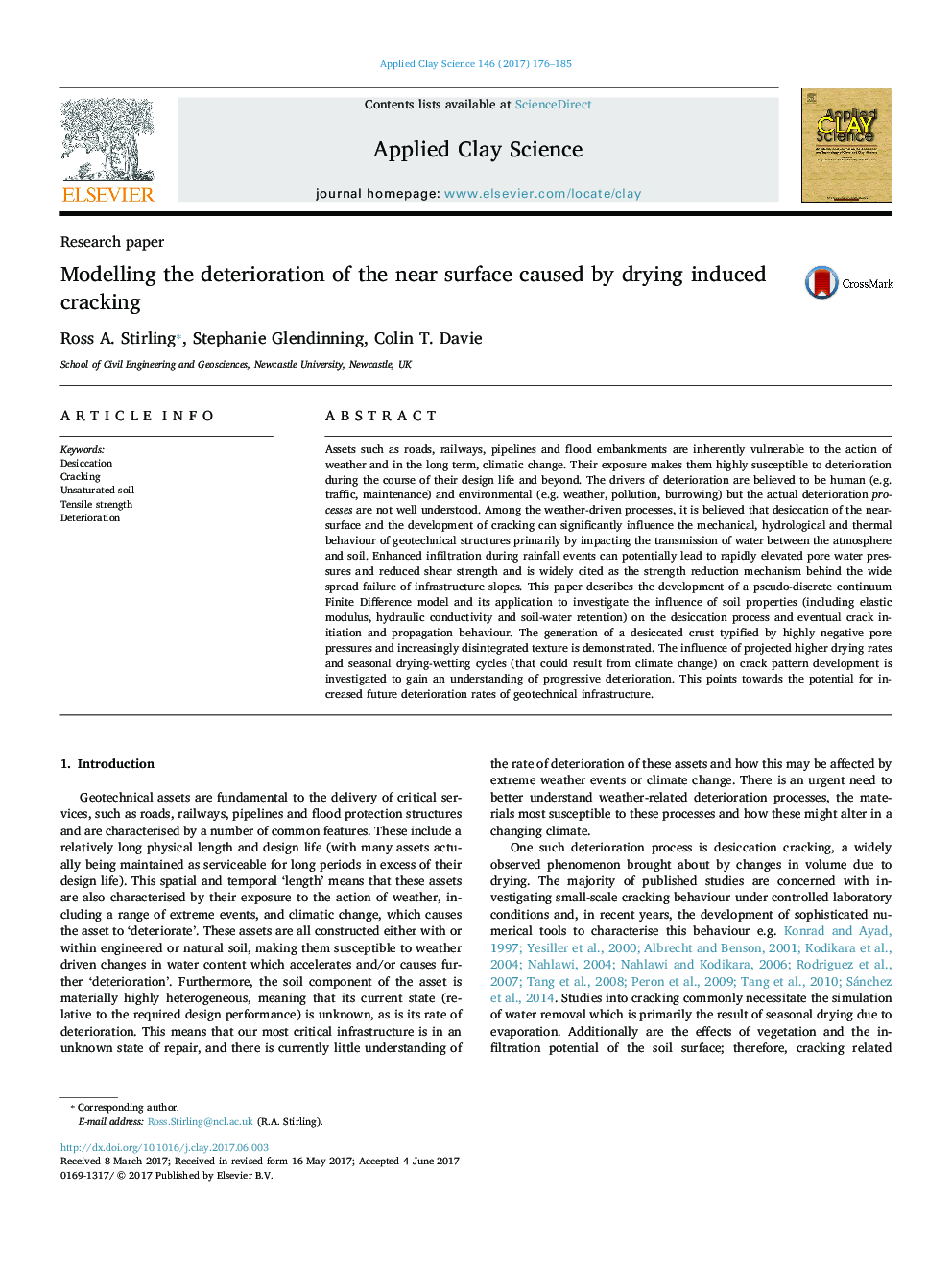| کد مقاله | کد نشریه | سال انتشار | مقاله انگلیسی | نسخه تمام متن |
|---|---|---|---|---|
| 5468841 | 1519042 | 2017 | 10 صفحه PDF | دانلود رایگان |
عنوان انگلیسی مقاله ISI
Modelling the deterioration of the near surface caused by drying induced cracking
ترجمه فارسی عنوان
مدل سازی تخریب سطح نزدیک به دلیل ترک خوردگی ناشی از خشک شدن
دانلود مقاله + سفارش ترجمه
دانلود مقاله ISI انگلیسی
رایگان برای ایرانیان
کلمات کلیدی
خشک کردن، ترک خوردن، خاک غیر اشباع، استحکام کششی، زوال،
ترجمه چکیده
دارایی هایی مانند جاده ها، خطوط راه آهن، خطوط لوله و سیلابها به طور ذاتی آسیب پذیر به شرایط آب و هوایی و در بلند مدت تغییرات اقلیمی می باشند. قرار گرفتن در معرض آنها باعث می شود تا آنها در طول عمر طراحی و فراتر از آن، در معرض بدتر شدن قرار گیرند. اعتقاد بر این است که رانندگان خراب شدن انسان (مثلا ترافیک، تعمیر و نگهداری) و محیط زیست (مانند آب و هوا، آلودگی، آبیاری) هستند، اما فرایندهای واقعی تخریب به خوبی درک نمی شود. در میان فرایندهای هوای محور، اعتقاد بر این است که خشک شدن سطح نزدیک و توسعه ترک خوردگی می تواند به طور قابل توجهی بر رفتار مکانیکی، هیدرولوژیکی و حرارتی ساختارهای ژئوتکنیک بویژه در اثر انتقال آب بین جو و خاک تاثیر بگذارد. نفوذ بیشتر در حوادث بارندگی به طور بالقوه منجر به افزایش فشار آب منفی و کاهش قدرت برشی می شود و به طور گسترده ای به عنوان مکانیسم کاهش قدرت در برابر شکست گسترده در دامنه های زیربنایی اشاره شده است. در این مقاله، توسعه مدل تقریبی مختلط پیوسته گسسته و استفاده از آن برای بررسی تاثیر خواص خاک (از جمله مدول الاستیک، هدایت هیدرولیکی و حفظ خاک-آب) بر روند فرآیندهای خشک سازی و رفتار ترکیبی نهایی و رفتار انتشار آن توصیف می شود. نسل پوسته خشک شده که به وسیله فشار منفی بسیار منفی و بافت به طور فزاینده تجزیه شده نشان داده شده است. تأثیر میزان پیش بینی شده خشک شدن بالاتر و چرخه های خشک شدن-چسبندگی فصلی (که می تواند منجر به تغییرات آب و هوایی) بر روی الگوی شکنی چرم شود، مورد بررسی قرار می گیرد تا بدین ترتیب بدست آید. این به سمت پتانسیل برای افزایش میزان وخامت در آینده زیرساخت های ژئوتکنیک است.
موضوعات مرتبط
مهندسی و علوم پایه
علوم زمین و سیارات
ژئوشیمی و پترولوژی
چکیده انگلیسی
Assets such as roads, railways, pipelines and flood embankments are inherently vulnerable to the action of weather and in the long term, climatic change. Their exposure makes them highly susceptible to deterioration during the course of their design life and beyond. The drivers of deterioration are believed to be human (e.g. traffic, maintenance) and environmental (e.g. weather, pollution, burrowing) but the actual deterioration processes are not well understood. Among the weather-driven processes, it is believed that desiccation of the near-surface and the development of cracking can significantly influence the mechanical, hydrological and thermal behaviour of geotechnical structures primarily by impacting the transmission of water between the atmosphere and soil. Enhanced infiltration during rainfall events can potentially lead to rapidly elevated pore water pressures and reduced shear strength and is widely cited as the strength reduction mechanism behind the wide spread failure of infrastructure slopes. This paper describes the development of a pseudo-discrete continuum Finite Difference model and its application to investigate the influence of soil properties (including elastic modulus, hydraulic conductivity and soil-water retention) on the desiccation process and eventual crack initiation and propagation behaviour. The generation of a desiccated crust typified by highly negative pore pressures and increasingly disintegrated texture is demonstrated. The influence of projected higher drying rates and seasonal drying-wetting cycles (that could result from climate change) on crack pattern development is investigated to gain an understanding of progressive deterioration. This points towards the potential for increased future deterioration rates of geotechnical infrastructure.
ناشر
Database: Elsevier - ScienceDirect (ساینس دایرکت)
Journal: Applied Clay Science - Volume 146, 15 September 2017, Pages 176-185
Journal: Applied Clay Science - Volume 146, 15 September 2017, Pages 176-185
نویسندگان
Ross A. Stirling, Stephanie Glendinning, Colin T. Davie,
